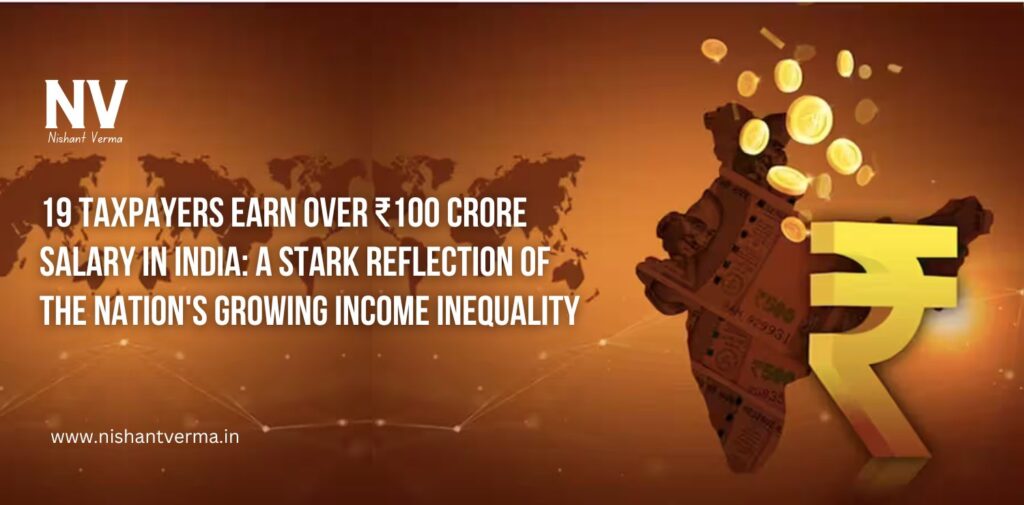India, a country with a population of over 150 crore people, is witnessing a stark and growing divide in income distribution. While the majority of the population struggles to make ends meet, a tiny fraction of taxpayers are raking in astronomical salaries. Recent data from Income Tax Returns (ITR) filings for FY 2023-24 has brought this disparity into sharp focus. According to the data, 19 taxpayers in India earned a salary exceeding ₹100 crore, and more than 1.17 lakh people earned over ₹21 crore annually. These figures are not just numbers but a reflection of the widening income gap in the country.
The Elite 19: Who Are They?
The revelation that 19 individuals in India earned over ₹100 crore in salary might raise eyebrows, but it is also a testament to the increasing concentration of wealth among a select few. These individuals are likely to be top executives of major corporations, CEOs of multinational companies, and successful entrepreneurs who have made it big in industries like technology, finance, and pharmaceuticals.
These high earners are a part of India’s economic success story, but their immense wealth also highlights the economic disparity that persists in the country. While these individuals enjoy the fruits of their hard work, it’s essential to recognize that their success is not the norm but the exception. The fact that only 19 individuals out of 150 crore people earned such high salaries underscores how skewed income distribution is in India.
A Nation of Unequal Earnings
When we look at the broader picture, the income disparity in India becomes even more apparent. Over 1.17 lakh people earned more than ₹21 crore in salary, a figure that places them in the top echelon of earners in the country. However, this group is still a minuscule percentage of the population, further highlighting the unequal distribution of income in India.

The disparity is not just in the number of high earners but also in the distribution of wealth across different sectors and regions. The majority of these high earners are concentrated in urban centers like Mumbai, Delhi, Bengaluru, and Hyderabad, where corporate headquarters and tech hubs are located. Rural areas, on the other hand, continue to struggle with poverty, lack of infrastructure, and limited economic opportunities. This urban-rural divide is one of the significant factors contributing to income inequality in India.
Moreover, the industries that these high earners belong to are typically those that benefit from globalization, technological advancements, and access to capital. This leaves behind sectors like agriculture, which still employs a large portion of the population but offers limited income potential. As a result, the wealth generated by these high earners does not trickle down to the rest of the population, creating a widening gap between the rich and the poor.
Why Are Taxpayers So Few?
Given India’s massive population, one might wonder why the number of taxpayers is so low, with only a tiny fraction earning substantial incomes. Several factors contribute to this scenario:
High Informal Sector: A significant portion of India’s workforce is employed in the informal sector, which includes jobs in agriculture, small-scale industries, and unorganized labor. These jobs often pay low wages and do not come under the purview of formal taxation, leading to a smaller tax base.
Tax Evasion and Avoidance: Tax evasion is another critical issue in India. Despite stringent tax laws, many individuals and businesses find ways to evade taxes through underreporting income, manipulating accounts, or exploiting loopholes in the tax system. This further reduces the number of taxpayers who accurately report and pay taxes on their earnings.

Lack of Awareness and Compliance: Many people in India are either unaware of their tax obligations or find the tax filing process too complicated. This is especially true for small business owners and individuals in rural areas, who may not have access to the resources or knowledge required to comply with tax regulations.
Income Thresholds: The government has set income thresholds below which individuals are not required to file taxes. Since a large portion of the population earns below these thresholds, they are not part of the taxpaying population. While this provides relief to low-income earners, it also means that the tax base remains narrow.
The Implications of Unequal Income Distribution
The concentration of wealth among a few individuals and the low number of taxpayers have significant implications for the Indian economy. Firstly, it exacerbates social inequality, as the benefits of economic growth are not shared equally across the population. This can lead to social unrest and dissatisfaction among those who feel left behind.

Secondly, a narrow tax base means that the government has fewer resources to invest in public services, infrastructure, and welfare programs. This, in turn, affects the quality of life for the majority of the population, particularly those in lower-income brackets.
Lastly, income inequality can stifle economic growth in the long run. When a large portion of the population has limited purchasing power, demand for goods and services remains low, hindering business expansion and job creation. This creates a vicious cycle where the rich get richer while the poor struggle to improve their economic situation.
Conclusion: Addressing the Income Divide
The income disparity in India is a complex issue that requires multifaceted solutions. While celebrating the success of high earners, it is crucial to address the systemic issues that contribute to income inequality. Expanding the formal sector, improving tax compliance, and creating opportunities for economic growth in rural areas are essential steps toward a more equitable distribution of wealth.
Moreover, the government must focus on progressive taxation policies that ensure the wealthy contribute their fair share to the nation’s development. By broadening the tax base and investing in social welfare programs, India can work towards a future where economic growth benefits all, not just a privileged few.
As the country continues to develop, it is vital to remember that true progress is measured not just by the success of a few but by the well-being of the many. Addressing income inequality is not just an economic imperative but a moral one that will define the future of India for generations to come.




